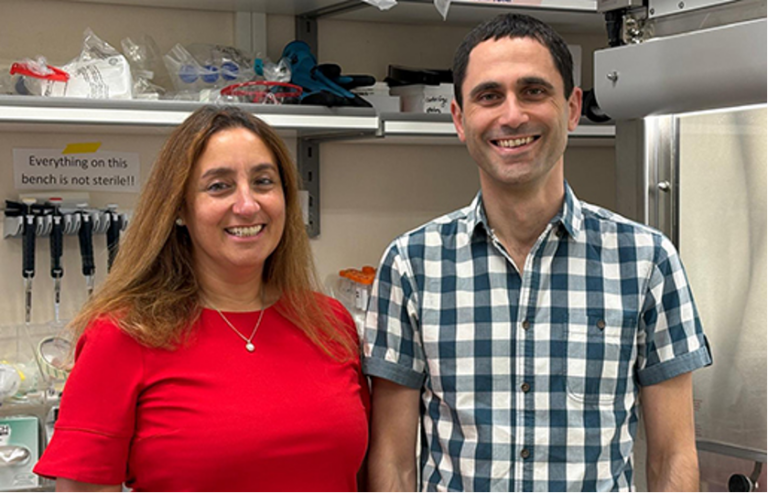Weizmann (Israël) : le microbiome joue un rôle clé dans l'obésité et dans les réactions aux médicaments

[:fr]Combien de microbes sont-ils installés en permanence dans notre corps ? Durant les dernières décennies, l’estimation généralement acceptée dans le monde scientifique est qu’il y a dix fois plus de cellules bactériennes que de cellules humaines. Or un calcul* effectué par des chercheurs de l’Institut Weizmann montre que l’adulte moyen possède un peu moins de 40 billions de cellules bactériennes, et environ 30 billions de cellules humaines, ce qui les met à peu près à égalité.
Les bactéries logées dans le corps humain jouent un rôle important pour la santé. La composition du microbiome d’une personne joue un rôle aussi bien dans la tendance à l’obésité que dans les réactions individuelles aux médicaments. Depuis quelques temps, certains scientifiques s’y réfèrent comme à un « second génome », et affirment qu’il faut le prendre en considération dans les traitements médicaux.
L’importance croissante du microbiome dans la recherche scientifique actuelle a amené le Pr Ron Milo, le Dr Shai Fuchs et le doctorant Ron Sender, tous trois de l’Institut Weizmann, à réexaminer l’opinion généralement admise sur le rapport entre les bactéries ‘personnelles’ et les cellules humaines. Ils ont entrepris cette recherche dans le cadre de leurs travaux pour la préparation du livre Cell Biology by the Numbers, récemment publié par Milo avec le professeur Rob Philips du California Institute of Technology. Comme le suggère son titre, ce livre est un recueil de connaissances acquises à la suite de calculs et d’estimations concernant les cellules vivantes.
L’estimation initiale, selon laquelle, dans le corps, les cellules bactériennes sont dix fois plus nombreuses que les cellules humaines, était basée, entre autres, sur l’hypothèse qu’une bactérie moyenne est environ mille fois plus petite qu’une cellule humaine moyenne. Mais en fait, le problème est que les cellules humaines ont une grande variété de tailles, et il en est de même pour les bactéries…
Suite de l’article dans Israël Science Info n°19 version papier
* Publication dans la revue Cell[:en]How many microbes inhabit our body on a regular basis? For the last few decades, the most commonly accepted estimate in the scientific world puts that number at around ten times as many bacterial as human cells. In research published in the journal Cell, a recalculation of that number by Weizmann Institute of Science researchers reveals that the average adult has just under 40 trillion bacterial cells and about 30 trillion human ones, making the ratio much closer to 1:1.
The bacteria living in our bodies are important for our health. The makeup of each person’s microbiome plays a role in both the tendency to become obese and in each individual’s reaction to drugs. Some scientists have begun referring to it as the “second genome,” recognizing that it needs to be taken into account when treating patients.
The rising importance of the microbiome in current scientific research led the Weizmann Institute’s Prof. Ron Milo, Dr. Shai Fuchs and research student Ron Sender to revisit the common wisdom concerning the ratio of “personal” bacteria to human cells.
Their research was undertaken as part of their work for the book Cell Biology by the Numbers, which was recently published by Milo and Prof. Rob Philips of the California Institute of Technology. The book, as the name suggests, is a compilation of insights gained from calculations and estimates about living cells.
The original estimate that bacterial cells outnumber human cells in the body by ten to one was based on, among other things, the assumption that the average bacterium is about 1,000 times smaller than the average human cell. The problem with this estimate is that human cells vary widely in size, as do bacteria. For example, red blood cells are at least 100 times smaller than fat or muscle cells, and the microbes in the large intestine are about four times the size of the often-used “standard” bacterial cell volume. The Weizmann Institute scientists weighted their computations by the numbers of the different-sized human cells, as well as those of the various microbiome cells. They also weighted their calculations for the quantities of “guest” bacteria in different organs in the body. For example, the bacteria in the large intestine dominate, in terms of overall numbers, all the other organs combined.
Milo says, “It is truly important to understand our microbiome, and research into this fascinating field is crucial for biomedical research. In the life sciences, which involve “messy” highly dynamic and variable systems, researchers sometimes tend to rely on qualitative rather than quantitative statements. But performing educated estimates in cell biology can serve as an extremely powerful tool. For those researchers who are proficient at hearing what the numbers tell them, estimates serve as a ‘sixth sense’ for understanding the lives of cells.”[:]







